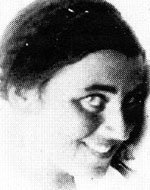Lipszyc (Herszewski), Leah
On the third day of Hanukkah, on the 17th of Kislev 5712 (17.12.1911) Leah was born in Moshav Ekron, Mazkeret Batya. Her father Shmuel Sharshavsky, one of the first children born in the area, arranged the land he received from his parents, Gershon and Michal, who came up with their first owners, and were among the founders of the moshava. Leah was born as a second daughter of the five daughters and son who were born to Elta and Shmuel. From an early age she helped with all the work in the house and in the yard, and even in the dairy that her family established. In addition to all these roles, she did not neglect her studies at the school, where she proved to be a good student, a devoted friend who loved both the students and the teachers. She joined the group of Scouts that was founded in Akron, and was connected to the Legion of Scouts in Jerusalem, which later merged with the Chugim in Tel Aviv and established the pioneering youth movement Mahanot Ha’olim. After completing her studies in the village, Leah continued at the WIZO Girls’ School in Tel Aviv where she received her first degree in agriculture and in the home agriculture. She met with Moshe Mosenson, who studied at Mikve Israel at the time, and they became a couple at the end of her studies. She spent a year in the Geva group in the Jezreel Valley, and in the summer of 1931 joined the group of groups that settled on the edge of Ein Harod. On the eve of Yom Kippur 1932, Leah gave birth to her firstborn, Dvora. The mother and daughter remained in the kibbutz in Ra’anana, and Moshe moved to Kibbutz Na’an, and in 1937 Leah was sent to study at the Hakibbutz Hameuchad seminary for five months. Then she went with her daughter to a year of training in the older Ashdot Yaakov farm where she met kibbutz member Yisrael Lifshitz and returned with her to her kibbutz, which founded the Maoz Hayim settlement in the Beit She’an Valley, where Lea built her new home. She was in charge of the children’s clothing store. With concern and good taste she tried to diversify and improve the children’s clothing despite the difficulties of the budget and its limitations. She also coordinated the Education Committee and was a member of the kibbutz secretariat several times. She did not cease her public activity despite the difficult pregnancy and the recruitment of her husband Israel Lifshitz as a driver recruited in Syria to the British army. In 1942, Leah gave birth to twin sons, Nadav and Assaf, during the Second World War, without a midwife with her when the time came for her to deliver. Even with the difficulty with two babies, Leah continued to carry on all her duties in her kibbutz, demanding a lot from herself and others, with a developed sense of responsibility, insisting on principles that seemed important to her. She was an active member of the Haganah. On a sunny day in the beginning of the month of Shevat, Leah went out for weapon training, kneeling like she was instructed on the ground. A tragic error resulted in her death, on 2 Shvat, 27.1.1944. She was 32 years old when she was killed while training with the Haganah. A tall, upright, handsome wife, with bright eyes and dark braids around her head. She was put to rest in the cemetery at Kibbutz Maoz Haim. Leah’s eldest daughter, Deborah Omer (Mosenson), who began to write for the children in the 1950s, described her mother’s character in several of her books, especially her story “Direct Hit”.
